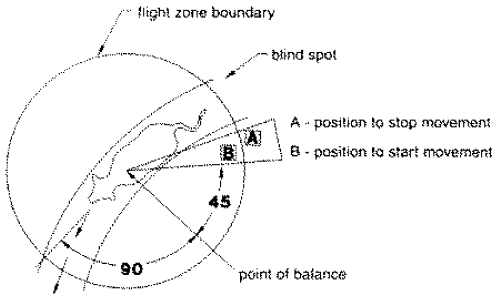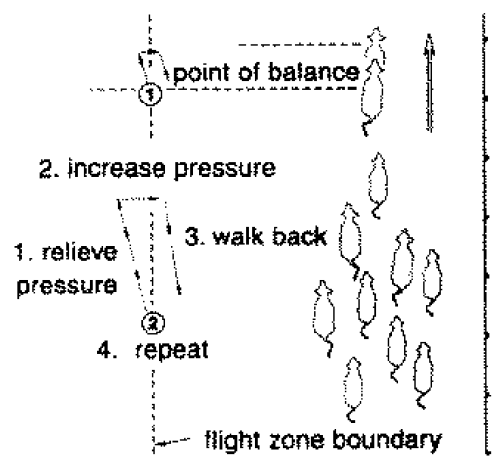| | The flight zone | Point of balance | Blind spot | Using the flight zone for handling and working purposes | Animals and their environment | Other safety considerations
On average, half of all farm related injuries in Alberta involve large animals, including cattle and horses. It is important for farmers working with livestock to anticipate and understand livestock behavior to minimize stress to the animal and to create a safe working environment.
Animal reactions to humans and other animals are guided by instincts. Animal handlers must be aware of natural animal instincts to handle livestock in a safe, stress-free environment. This factsheet provides a brief overview on using the flight zone of livestock (cattle in particular) to move and handle livestock in a safe, low stress manner (Figure 1).

Figure 1. The flight zone
The Flight Zone
In simple terms, the flight zone is an animal's personal space. It is the minimum distance the animal will try to maintain between itself and any perceived threat. It is an area found with all animals, but most commonly associated with cattle and horses.
The flight zone will vary between animals; the flight zone of a range cow may be as large as 90 metres (300 ft), while a feedlot animal has a flight zone of between 1.5 and 7.5 metres (5 and 25 ft.).
The flight distance is also affected by handling techniques; bad experiences with a handler will result in an increased flight zone. An understanding of the flight zone will allow handlers to move animals calmly and safely.
Point of Balance
The point of balance is usually located at the animal's shoulder. Cattle will move forward in a chute or pen when the handler passes the point of balance in the opposite direction.
Blind Spot
Large animals also have a blind spot located directly behind them. Animals cannot see objects in this area and will usually kick if they become aware of any activity in this area.
Using the Flight Zone for Handling and Working Purposes
The handler's body position should always be relative to the animal's personal space and point of balance. An animal will respond to an invasion of its personal space. The approaching pressure will affect the animal's reaction to the handler. When an animal becomes stressed, it takes 20 to 30 minutes for the animal to calm down.
By using the point of balance, animals can be trained to move in desired directions without stress. When a handler is outside the flight zone, the animal will turn and face the handler to understand his or her intentions.

Figure 2. Moving working group
When a handler goes inside the flight zone, the animals will turn away and head in the opposite direction. Moving animals requires the handler to alternate between penetrating and withdrawing from the flight zone. Penetration makes the animal move, and backing off makes the animal stop. When an animal panics or feels trapped because the handler has penetrated too far into its flight zone, the handler must back off and let the animal regain its confidence. Using instinctual behaviors of livestock allows handlers to use low stress techniques; this approach adds to the safety of the handling system.
Cattle have a tendency to bunch together, so handlers can use this factor to their advantage when herding and moving cattle. Due to the strong herd instinct, cattle are likely to become highly agitated when separated. Try to keep cattle together or allow to them to move with a "buddy." When an animal feels cornered, it may panic, jump or run back, thus injuring the handler. Allow animals to move at their own speed and follow a leader.
Too many animals in a crowded pen can cause panic and can increase the chance of handlers being crushed or otherwise injured. Handlers should also watch for behavioral changes, especially in non-castrated males and in maternal animals.
Animals and Their Environment
| 1. | When an animal enters a new area, allow it time to get used to the surroundings without fear or pain, or it will not readily enter the area again. |
| 2. | Livestock have limited depth perception, which is why they stop and lower their heads to glance at an object. |
| 3. | Animals will balk at a change in flooring surface or texture. Minimize shadows and bright spots. Give livestock time to become oriented to slatted flooring. |
| 4. | Animals become attached and comforted by their own areas and can get territorial as a result. |
| 5. | Livestock are easily distracted; take away moving or flapping objects. Solid sides on handling facilities prevent animals from seeing distractions. |
Other Safety Considerations
| 1. | Respect the size of your livestock. |
| 2. | Always work with another person. |
| 3. | Plan an escape route. |
| 4. | Hitting or forcing an animal will only increase the animal's stress and your likelihood of being injured. |
| 5. | Livestock are sensitive to loud/high frequency noises and quick movements; eliminate these factors where possible. |
| 6. | Never wrap or tie a lead rope to yourself. |
Conclusion
Large animals should not be feared, but respected. A knowledge of animal instincts and behavior allows handlers to work calmly with animals, resulting in less stress for the animal and fewer injuries to the handler.
References
Understanding Flight Zone and Points of Balance
Dr. Temple Grandin's Website
Low Stress Cattle Handling,, Institute of Agricultural Research and Environmental Health (I.ARE.H.)
Source: Agdex 086-4. March 2004. |
|